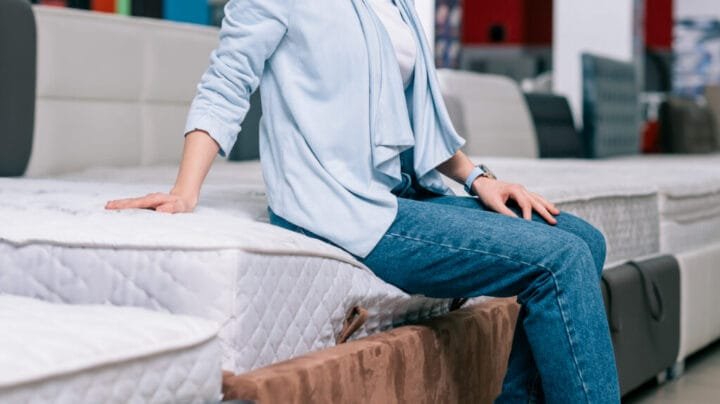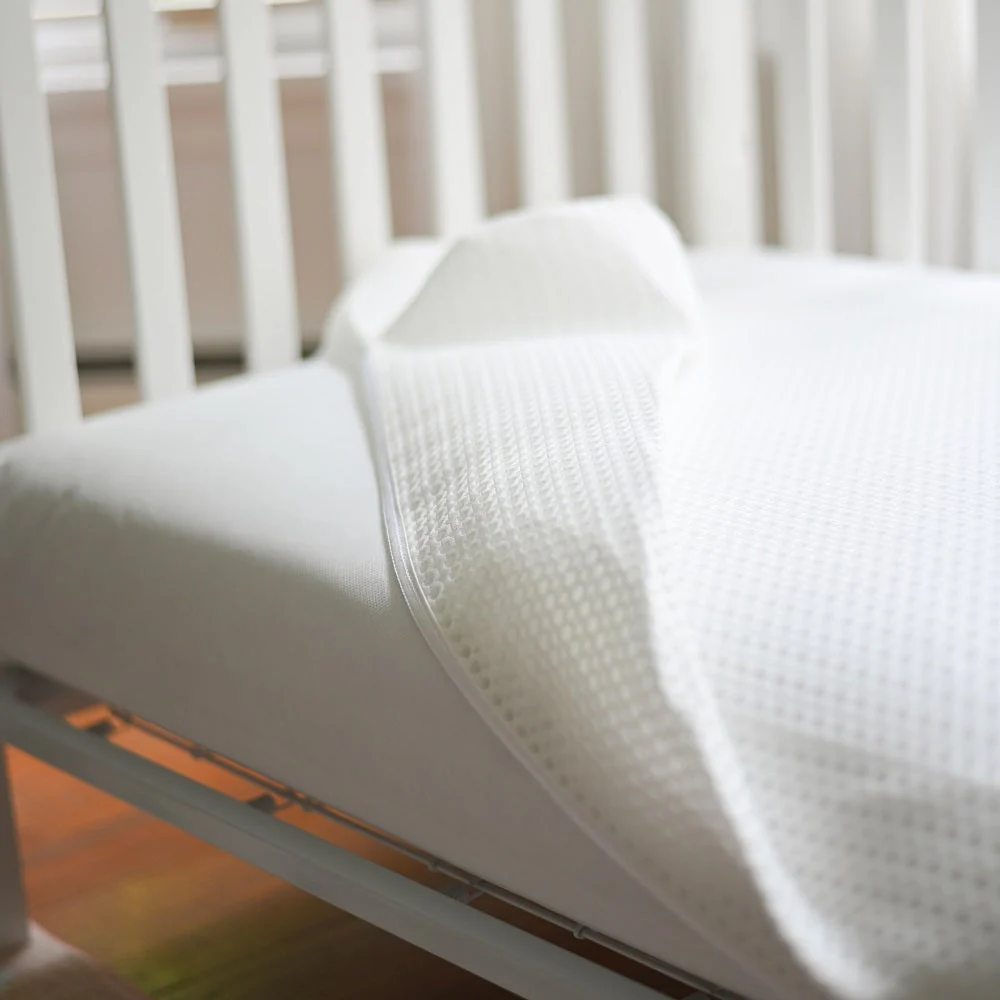Do you frequently wake up sneezing or coughing or notice a stuffy nose and irritated eyes when you leave? If so, you’re not alone.
Allergies and asthma often flare up in the bedroom, where dust mites, pet dander, and other allergens can accumulate. However, the right mattress and bedding can help reduce these triggers and improve sleep quality.
In this article, we’ll cover the best materials and features for an allergen-free sleep and recommend the best allergy-friendly mattress options.
Table of Contents
Common Bedroom Allergens and Their Impact
Dust Mites
Where They Thrive: Warm, humid environments such as pillows, mattresses, and upholstered furniture.
Symptoms: Sneezing, itchy eyes, and congestion can worsen, especially if lying down. A high-quality, hypoallergenic mattress protector can reduce exposure to dust mites and help keep the mattress clean and dry, promoting a healthier sleep environment.

Pet Dander
Where It Hides: Tiny skin flakes and hair from cats, dogs, or other pets can be embedded in bedding and carpets. Using mattress protectors can also help reduce pet dander exposure.
Symptoms: Coughing, difficulty breathing, or nasal irritation if you’re sensitive to animal allergens.
Mold and Mildew
Where They Grow: Damp or poorly ventilated areas, including mattress surfaces or under-bed storage.
Symptoms: Can exacerbate asthma and lead to respiratory issues.

Pollen
How It Enters: Open windows or clinging to clothing, hair, and pets.
Symptoms: Runny nose, red eyes, and sore throat during high-pollen seasons.
What is a Hypoallergenic Mattress?
A hypoallergenic mattress is designed to create a healthier sleep environment by minimizing the presence of common allergens such as dust mites, mold, and mildew.
These mattresses are crafted from materials that naturally resist these allergens, making them an excellent choice for individuals with allergies or asthma. By reducing allergen exposure, hypoallergenic mattresses can help alleviate allergy symptoms and improve overall sleep quality.
Definition of a Hypoallergenic Mattress
A hypoallergenic mattress is specifically constructed using materials resistant to allergens like dust mites, mold, and mildew.
These materials help prevent the accumulation of allergens within the mattress, providing a cleaner and healthier sleeping surface. This means fewer nighttime disruptions and more restful sleep for allergy sufferers.
Benefits of a Hypoallergenic Mattress
Investing in a hypoallergenic mattress offers several significant benefits:
- Reduced Allergy Symptoms: Hypoallergenic mattresses minimize the presence of allergens, helping to reduce symptoms such as sneezing, itchy eyes, and congestion.
- Improved Sleep Quality: A cleaner environment free from allergens can lead to better sleep quality, allowing you to wake up refreshed and energized.
- Relief from Respiratory Issues: Hypoallergenic mattresses can relieve exposure to triggers like dust mites and mold for those with asthma or other respiratory conditions.
Types of Hypoallergenic Mattresses
When it comes to hypoallergenic mattresses, there are several types to choose from, each offering unique benefits to allergy sufferers.
Memory Foam Mattresses
Memory foam mattresses are popular choices for those seeking hypoallergenic options. Made from viscoelastic polyurethane foam, they naturally resist dust mites and mold.

The dense structure of memory foam prevents allergens from settling deep within the mattress, making it an ideal choice for individuals with allergies or asthma.
Memory foam mattresses are known for their ability to conform to the body’s shape, providing excellent pressure relief and support.
Some popular memory foam mattresses include:
- Tempur-Pedic Cloud Supreme Breeze: This mattress features a layer of Tempur-Pedic’s proprietary memory foam, designed to provide exceptional pressure relief and support while maintaining a cool sleeping surface.
- Sleep Innovations Contour Supreme: This mattress, with a layer of contouring memory foam, adapts to the body’s shape, offering personalized support and comfort.
- Lucid 10-inch Memory Foam Mattress: This mattress combines memory foam’s pressure-relieving properties with resistance to dust mites and mold, ensuring a healthier sleep environment.
By choosing a memory foam mattress, you can enjoy both the comfort and hypoallergenic benefits that contribute to a better night’s sleep.
Choosing the Right Mattress for Allergy and Asthma Relief
Hypoallergenic Materials
Latex: Naturally resistant to dust mites and mold, it is an excellent option for asthma and allergy sufferers. Natural latex is also hypoallergenic and eco-friendly, derived from the sap of rubber trees without harmful chemicals.
Memory Foam: Its dense structure may help prevent dust mites from settling deep within the mattress. Gel-infused memory foam offers additional benefits, such as enhanced cooling properties and allergen resistance, making it ideal for various sleeping positions.
Gel-Infused Foams: Cooling properties can reduce moisture buildup, discouraging allergens like mold. Organic cotton covers contribute to breathability and moisture-wicking properties, enhancing overall comfort for individuals with allergies or sensitivities.
Anti-bacterial and Anti-Dust Mite Covers

Encasements: A full mattress encasement with a tightly woven zipper can lock out dust mites and other allergens. An organic cotton cover is hypoallergenic and eco-friendly, enhancing comfort and moisture-wicking properties.
Easy to Clean: Look for machine-washable covers to help maintain a hygienic surface.
Certifications and Labels
OEKO-TEX® Standard 100: Ensures the mattress and its materials are free from harmful substances.
CertiPUR-US®: Foam in the mattress meets standards for low VOC (volatile organic compounds) emissions and is made without certain harmful chemicals.
Bedding Essentials for Allergy and Asthma Control
Pillow Selection
Hypoallergenic Fill: Options like latex, memory foam, or buckwheat are less likely to harbor dust mites.
Washable Covers: Use pillow protectors that can withstand hot water washes. A firm hypoallergenic mattress can also provide excellent support while reducing allergens, making it ideal for individuals with allergies or asthma.
Sheets and Duvet Covers
Natural Fibers: Cotton or bamboo sheets promote breathability and reduce moisture. An organic cotton cover can enhance its hypoallergenic and moisture-wicking properties, making it ideal for individuals with sensitivities or allergies.
Frequent Washing: Daily, in hot water (at least 60°C / 140°F), Launder bedding weekly to kill dust mites.
Duvets and Comforters
Synthetic vs. Down: High-quality synthetic materials are easier to clean and less likely to trigger allergies than some downfalls.
If you prefer down, look for hypoallergenic, sterilized versions. A latex mattress is an excellent hypoallergenic option as it resists dust, mites, and mold, making it ideal for individuals with allergies or sensitivities.
Protective Casings: A duvet cover is a barrier against dirt, allergens, and oils and is far simpler to wash regularly than the entire comforter.
Maintenance Tips to Keep Allergens at Bay
Regular Vacuuming
Vacuum your bedroom flooring, especially under and around the bed, to remove dust, hair, and pet dander.
Consider a vacuum with a HEPA filter to trap tiny particles.
Adequate Ventilation
Open windows regularly (if pollen counts allow) or use an air purifier with a HEPA filter.
Avoid excessive humidity using a dehumidifier, aiming for 30–50% humidity.
Frequent Mattress Rotation
If your mattress design allows it, rotate (or flip, if it is double-sided) it every 3–6 months. This practice prolongs the mattress’s life and helps reduce localized allergen buildup.

A hybrid mattress, which combines foam, latex, and innerspring coils, offers excellent support and allergen resistance, making it a great choice for maintaining a clean sleep environment.
Declutter Your Bedroom
Minimize plush toys, heavy drapes, and thick rugs that can collect dust and pollen.
Store seasonal items in sealed containers to avoid extra dust accumulation.
Wash or Replace Air Filters
Clean your air conditioning and heating filters regularly to maintain good indoor air quality.
Replace filters every 2–3 months or as recommended by the manufacturer.
Contact us today and get the best offer!
Additional Measures for Asthma-Friendly Sleep
Elevate Your Head
A slightly elevated sleeping position (such as an adjustable bed or an extra pillow) can keep the airways open and reduce nighttime coughing.
Also, choosing a mattress that provides adequate support for stomach sleepers is crucial to maintaining proper spinal alignment.
Keep Pets Out
As much as we love our furry friends, limiting their access to the bedroom can significantly lower dander levels.
Monitor for Triggers
Pay attention to new décor or cleaning products containing irritants or strong scents triggering asthma symptoms.
Conclusion
With the right mattress, bedding, and maintenance routine, you can drastically reduce allergens in your bedroom. This will lead to less congestion, fewer asthma flare-ups, and better sleep.
It’s worth investing in hypoallergenic materials and adopting a proactive cleaning schedule to ensure you and your loved ones feel refreshed each morning.
read more articles: Eco-Friendly Mattress Options: Sustainable Sleep Solutions
How Sinyora Yatak Can Help
At Sinyora Yatak, we specialize in creating sleep solutions that cater to diverse needs, including those with allergies or asthma.
Explore our range of hypoallergenic mattresses, breathable bedding, and protective covers to keep dust mites and other allergens at bay. Contact us or visit our showroom to learn how we can help you achieve a healthier night’s rest.
Frequently Asked Questions (FAQ)
What type of mattress is best for allergy sufferers?
The best mattress for allergy sufferers is made from hypoallergenic materials, such as memory foam, latex, or gel-infused foams. These materials are naturally resistant to dust mites, mold, and mildew, making them ideal for reducing allergens in the sleep environment.
Is foam or spring mattresses better for allergies?
Foam mattresses, particularly memory foam and latex, are generally better for allergies than spring mattresses. Their dense structure prevents allergens from settling deep within, offering a cleaner and healthier sleeping surface.
Do they make hypoallergenic mattresses?
Yes, manufacturers produce hypoallergenic mattresses specifically designed to minimize allergens. These mattresses often use memory foam, latex, and organic cotton covers to resist dust mites and mold.
What is a hypoallergenic bed?
A hypoallergenic bed reduces allergens and provides a cleaner sleep environment. It typically includes a hypoallergenic mattress, bedding, and protective covers that resist dust mites, mold, and other common allergens.
How can I maintain a hypoallergenic mattress?
To maintain a hypoallergenic mattress, use a protective mattress cover, wash bedding regularly, vacuum the bedroom frequently, and ensure proper ventilation to reduce moisture and allergen buildup.
Can mattress protectors help with allergies?
Yes, mattress protectors can significantly help with allergies by providing a barrier against dust mites, pet dander, and other allergens. Look for hypoallergenic and waterproof options for added protection.
How often should I replace my mattress if I have allergies?
For allergy sufferers, it’s recommended to replace the mattress every 7-10 years or sooner if you notice an increase in allergy symptoms or if the mattress shows signs of wear that could harbor allergens.



